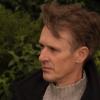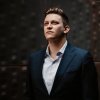An afternoon of piano four hands is a rarity. Not only must two concert pianists meet in skill, but they must also share a mind, body, and soul — or at least reach a consensus in style. Too unalike and the concert becomes a battlefield with clashes of interpretation everywhere.
Such was the case during last Sunday’s concert at Berkeley’s First Church of Christ Scientist, where opera coaches Peter Grünberg and John Parr teamed up to launch the 14th annual Lieder Alive! recital series. Given the organization’s focus, Grünberg and Parr played plenty of lieder throughout, with some pieces transcribed for solo piano and others arranged for four hands. Grünberg and Parr’s performances of the largely Romantic-era program, however, lacked clarity, and exhibited their own incompatibility more than the beauty of the songs.
Thomas Kinch, a Welsh tenor and current Adler Fellow of the San Francisco Opera, joined the pianists for performances of two arias by Richard Wagner, dazzling the audience with sorely needed radiance to conclude the program. To be clear, no singing took place before Kinch, but it was not because of this that the earlier pieces felt voiceless.
Grünberg played three solo transcriptions by Franz Liszt — Robert Schumann’s “Widmung,” and Franz Schubert’s “Frühlingsglaube” and “Auf dem Wasser zu singen.” One could hardly recognize these pieces as lieder. Grünberg’s touch was too bright and too sharp, divesting the melodies of their vocal warmth. With unbridled rubato, he too often struck the piano at full force. Wrong notes were the frequent casualties of his vigor: “Auf dem Wasser zu singen” suffered an erroneous F in place of a climactic F-flat; “Frühlingsglaube” fell victim to the caprices of Grünberg’s tempo; “Widmung” drowned in sloppy, boisterous arpeggios.
The difference between Parr’s and Grünberg’s styles could not have been starker. When Parr followed Grünberg’s performances with Liszt’s transcription of Schumann’s “Frühlingsnacht,” his notes were sweeter, his rubato subtler — it felt as though the piano had shapeshifted.
That led to problems with Grünberg and Parr’s subsequent four-hand performance of Felix Mendelssohn’s Lieder ohne Worte. Indeed, their hands butted heads, each musician insisting on a different color. At times a showy melody by Grünberg overwhelmed a mellow accompaniment by Parr. Other times, the two pianists became lost in their own interpretations and fought unwittingly for the spotlight. Amid these battles Mendelssohn’s melodies all but disappeared.
Swooping in to end the concert, Kinch’s performance of two arias from Richard Wagner’s Die Walküre rescued the pianists from each other. Parr accompanied Kinch on the majestic “Winterstürme wichen dem Wonnemond” (Winter storms have vanished) and Grünberg accompanied him on the heroic “Siegmund heiss' ich und Siegmund bin ich!” (Siegmund, I am named). Kinch sang the first with tender grace and the second with bold passion. The humble room at First Church could hardly contain his voice. Lighting every dark corner of the hall, Kinch exuded a power too great for even the pianists to match, and when he had finished the audience applause was almost as thunderous as his performance. By the way he projected, it was clear he’ll be claiming roles in major opera houses before long.
The concert did include some non-lieder works. For all their differences, Grünberg and Parr joined forces to great effect in those pieces. Their strengths shone during Johannes Brahms’s lively, playful Hungarian Dances and a transcription of Richard Strauss’s whimsical symphonic poem Till Eulenspiegel’s Merry Pranks. This performance, unsurprisingly a crowd favorite, was theatrical and full of character, with dynamics exaggerated and dramatic pauses taken. It was here that the two demonstrated the experience gained from their illustrious careers as repetiteurs, masters of the theater.




